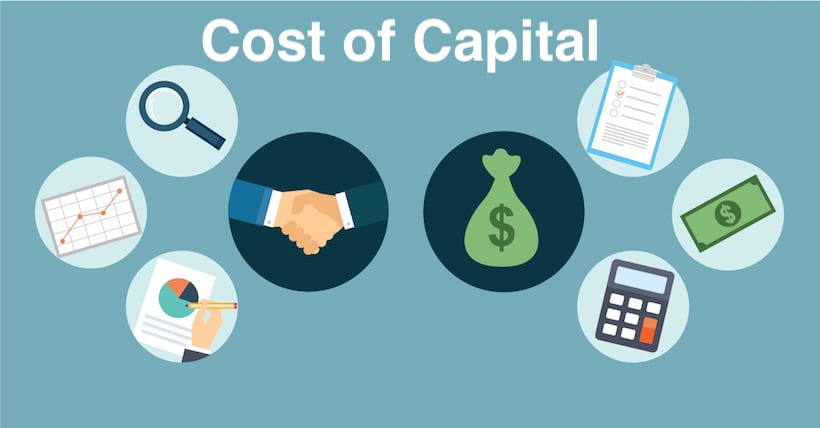Illustration 1
Presume a software company has a target capital structure of 50% equity and 50% debt. Over the subsequent year it plans to enhance $100 millions partly by issuing at after tax cost of 4% and remaining by issuing equity shares at $175 per share of 6% per share. Determine the overall cost of capital.
Solution
In order to maintain the target capital structure of $100 millions it will enhance 50% of it through issuing new equity shares at the cost of 6% per share and 50% of it through selling bonds at the cost of 4%.
It has to be noted that no adjustment on capital. Therefore, the overall cost of capital is
Rc = Wd Rd + We Re
Substituting the value of We paritying to 50 percent which is 0.50, Re parities to 6 and Wd paritying to 50 percent which is 0.50, Rd parities to 4, we have
Rc = 0.50 * 6 + 0.50 * 4
= 3 + 2 = 5
Therefore, overall cost of capital is 5 percent which will be used to evaluate all capital outlay projects to decide whether or not to undertake a project.
Illustration 2
Presume a software company has a current capital structure of 70% and equity and 30% debt and financial managers of the company do not want to change its capital structure.
The company devices to finance in the subsequent year 150 million dollars capital budget through using retained earnings at the capital cost of 8% per share and by issuing long term bonds at 7% interest rate. Moreover, presume that 27% is the marginal tax rate.
Compute the weighted or overall cost of capital.
Solution
Note that financing capital budget through using retained earnings is considered at nominal value with lifting finance by externally issuing shares and debt in the open market.
Moreover, in the provided details, cost of debt capital is not directly mentioned. In its place, interest rate on the bonds issue is provided.
As interest payments are deductible from income to reach at taxable income adjustment has to be made on this count to estimate the true cost of debt capital.
With 27 percent of income tax, after tax cost of debt capital will be as follows:
Rd = Ri (1-t)
= 7 (1 – 0.27)
= 7 * 0.73 = 5.11
Rc = We Re + Wd Rd
We = 70 per cent that is 0.70
Re = 8 percent
Wd = 30 percent, which is 0.30
Rd = Ri (1-t)
Rc = We Re + Wd * Ri (1-t)
= 0.70 * 8 + 0.30 * 5.11
= 5.6 + 1.533 = 7.133
Illustration 3
Presume the return on government securities is 10% and a bond of an industry capitulate 14 percent. Compute
Aggregate Risk Premium
Cost of Equity Capital of the industry
Solution
The component of risk premium P1 is provided by the surplus of the rate of interest on an industry’s bonds which is 14% over the risk free interest on government’s bonds which is 10%.
Therefore,
P1 = 14 – 10 = 4%
The next component of risk is purchasing industry’s common stock that is common shares quite than bonds is usually presumed to be paritying to 5% higher than the return on bonds.
Therefore, Aggregate Risk premium is
Rp = P1 + P2
= 14 – 10 + 5 = 9 percent
Cost of equity capital,
Re = Rf + P1 + P2
= 10 + 4 + 5 = 19 percent
Illustration 4
The present rate of common stock of an industry is $5. The industry has just paid a dividend of 50 cents per share in the current year and anticipates that its dividend will increase in prospect at an invariable rate of 10% every year.
Compute the industry’s cost of equity capital using discounted cash flow method that is dividend valuation method.
Solution
Dividend per share D = 50 cents
Price of share P = $5 = 500 cents
G = 10% or 0.10
Cost of Equity Capital
Re = D + G
P
= 50 + 0.10
500
= 1 + 0.10
50
= 0.02 + 0.10
= 0.12 or 12 percent
Illustration 5
Presume shares of another software industry are sold in the open market at $100 per share. The industry decides its dividend of $10 per share. Security analysts evaluate that the yearly increase of the industry will be 15%. What would be the cost of equity for this company?
Solution
Cost of capital is the required rate of return by the investors
D = $10
P = $100 per share
G = 15%
Therefore,
Re = 10 + 0.15
100
= 1 + 0.15
10
= 0.10 + 0.15
= 0.25 or 25 percent
Illustration 6
Presume a company has a beta coefficient showing variability of return on its common stock has been evaluated to be equal to 0.65. Rate of interest on government bonds is 6.5% and the average return on the common stock on the market entirely is 10.5 percent.
Determine the cost of equity capital for the company using Capital Asset Pricing Model CAPM.
Solution
Cost of equity capital Re = Rf + β (Rm – Rf)
Rf = Risk free return which equals 6.5%
Rm = Return on the average stock on the market as a whole which parities 10.5%
β = 0.65
Substituting the values in the CAPM model, we get
Re = 6.5 + 0.65 * (10.5 – 6.5)
= 6.5 + 2.6 = 9.1
Therefore, cost of equity capital equals 9.1%.


